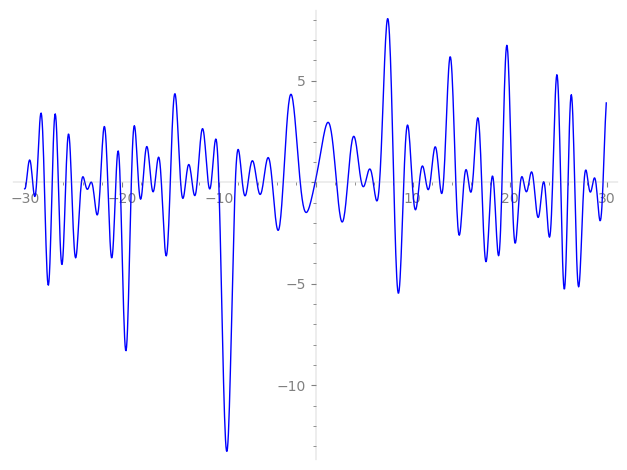| L(s) = 1 | + (0.866 + 0.5i)2-s + (−2.29 − 1.32i)3-s + (0.499 + 0.866i)4-s + (−1.32 − 2.29i)6-s − 3.64i·7-s + 0.999i·8-s + (2 + 3.46i)9-s − 4.64·11-s − 2.64i·12-s + (1.73 − i)13-s + (1.82 − 3.15i)14-s + (−0.5 + 0.866i)16-s + 3.99i·18-s + (−1.67 + 4.02i)19-s + (−4.82 + 8.35i)21-s + (−4.02 − 2.32i)22-s + ⋯ |
| L(s) = 1 | + (0.612 + 0.353i)2-s + (−1.32 − 0.763i)3-s + (0.249 + 0.433i)4-s + (−0.540 − 0.935i)6-s − 1.37i·7-s + 0.353i·8-s + (0.666 + 1.15i)9-s − 1.40·11-s − 0.763i·12-s + (0.480 − 0.277i)13-s + (0.487 − 0.843i)14-s + (−0.125 + 0.216i)16-s + 0.942i·18-s + (−0.384 + 0.923i)19-s + (−1.05 + 1.82i)21-s + (−0.857 − 0.495i)22-s + ⋯ |
\[\begin{aligned}\Lambda(s)=\mathstrut & 950 ^{s/2} \, \Gamma_{\C}(s) \, L(s)\cr =\mathstrut & (-0.970 - 0.239i)\, \overline{\Lambda}(2-s) \end{aligned}\]
\[\begin{aligned}\Lambda(s)=\mathstrut & 950 ^{s/2} \, \Gamma_{\C}(s+1/2) \, L(s)\cr =\mathstrut & (-0.970 - 0.239i)\, \overline{\Lambda}(1-s) \end{aligned}\]
Particular Values
| \(L(1)\) |
\(\approx\) |
\(0.0162030 + 0.133230i\) |
| \(L(\frac12)\) |
\(\approx\) |
\(0.0162030 + 0.133230i\) |
| \(L(\frac{3}{2})\) |
|
not available |
| \(L(1)\) |
|
not available |
\(L(s) = \displaystyle \prod_{p} F_p(p^{-s})^{-1} \)
| $p$ | $F_p(T)$ |
|---|
| bad | 2 | \( 1 + (-0.866 - 0.5i)T \) |
| 5 | \( 1 \) |
| 19 | \( 1 + (1.67 - 4.02i)T \) |
| good | 3 | \( 1 + (2.29 + 1.32i)T + (1.5 + 2.59i)T^{2} \) |
| 7 | \( 1 + 3.64iT - 7T^{2} \) |
| 11 | \( 1 + 4.64T + 11T^{2} \) |
| 13 | \( 1 + (-1.73 + i)T + (6.5 - 11.2i)T^{2} \) |
| 17 | \( 1 + (8.5 + 14.7i)T^{2} \) |
| 23 | \( 1 + (1.42 - 0.822i)T + (11.5 - 19.9i)T^{2} \) |
| 29 | \( 1 + (-0.822 - 1.42i)T + (-14.5 + 25.1i)T^{2} \) |
| 31 | \( 1 + 5.64T + 31T^{2} \) |
| 37 | \( 1 + 0.354iT - 37T^{2} \) |
| 41 | \( 1 + (-0.145 + 0.252i)T + (-20.5 - 35.5i)T^{2} \) |
| 43 | \( 1 + (9.77 + 5.64i)T + (21.5 + 37.2i)T^{2} \) |
| 47 | \( 1 + (3.77 - 2.17i)T + (23.5 - 40.7i)T^{2} \) |
| 53 | \( 1 + (10.8 - 6.29i)T + (26.5 - 45.8i)T^{2} \) |
| 59 | \( 1 + (3.96 - 6.87i)T + (-29.5 - 51.0i)T^{2} \) |
| 61 | \( 1 + (0.468 + 0.811i)T + (-30.5 + 52.8i)T^{2} \) |
| 67 | \( 1 + (0.559 - 0.322i)T + (33.5 - 58.0i)T^{2} \) |
| 71 | \( 1 + (-1.35 + 2.34i)T + (-35.5 - 61.4i)T^{2} \) |
| 73 | \( 1 + (1.47 + 0.854i)T + (36.5 + 63.2i)T^{2} \) |
| 79 | \( 1 + (2 - 3.46i)T + (-39.5 - 68.4i)T^{2} \) |
| 83 | \( 1 - 7.93iT - 83T^{2} \) |
| 89 | \( 1 + (-44.5 + 77.0i)T^{2} \) |
| 97 | \( 1 + (3.21 + 1.85i)T + (48.5 + 84.0i)T^{2} \) |
| show more | |
| show less | |
\(L(s) = \displaystyle\prod_p \ \prod_{j=1}^{2} (1 - \alpha_{j,p}\, p^{-s})^{-1}\)
Imaginary part of the first few zeros on the critical line
−9.992632942775535574452868461147, −8.287940198819691767109612741522, −7.56742540277880927380207457437, −6.97100446047005060840423794484, −6.06073600335430498064224183482, −5.39897243701623023823881616408, −4.48353292728468646038002503869, −3.34683733442975236651821018287, −1.59784405258202611594329857388, −0.05791144585847299424523463822,
2.14097735135600506508329049775, 3.30015015598678295047312669984, 4.70455103236211327203464752780, 5.13168135145199838390041585879, 5.92438851975826769068964688454, 6.58025060172101681765092038050, 8.044611673687339555420391307274, 9.075028113706591982973945110810, 9.946178613055937216003337907958, 10.68660032989427183593970595119

